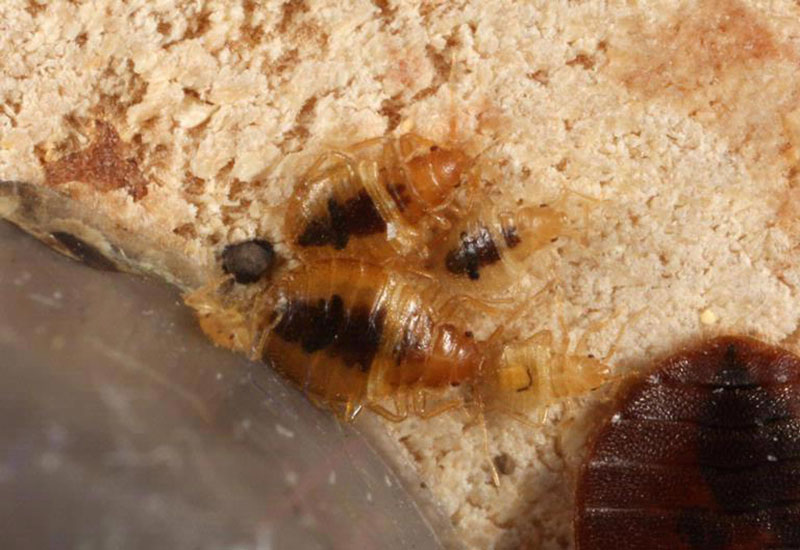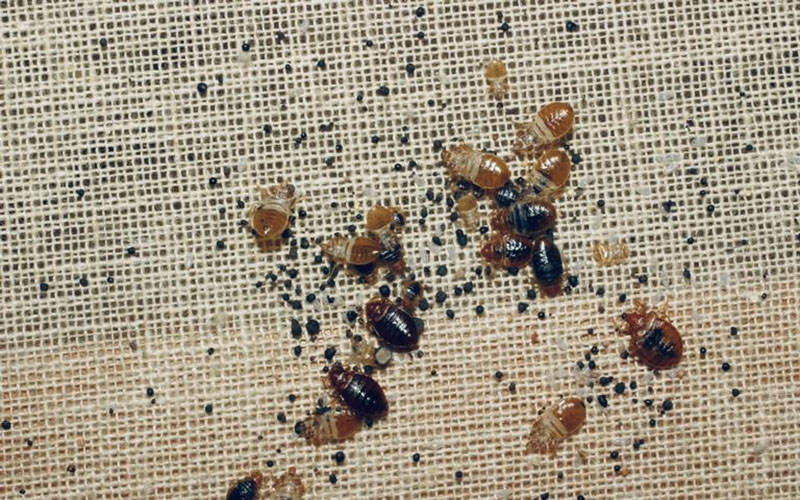Bed Bugs: Reduce Risk While Thrift Shopping
Thrift shopping can be fun! Shopping second-hand can help save money. Thrift shops sell everything from everyday necessities such as dishes and clothing to larger purchases such as furniture. Thrift shops are bursting with vintage and unique items that appeal to collectors and people wanting something they can’t find in new retail stores. Occasionally, rare and valuable things are found in thrift shops. There is an art to thrift shopping. Finding treasures takes time and practice. Don’t spoil your fun by taking home an unwanted pest (Figure 1).
Figure 1. Bed bug. Photo credit: Gary Alpert, Harvard University, University of Georgia Center for Invasive Species and Ecosystem Health
What do Bed Bugs Look Like?
Bed bugs are small, flat, oval-shaped and red to dark brown in color. Adult bed bugs look like an apple seed, but are somewhat smaller (U.S. Environmental Protection Agency, 2015). They can be seen with the naked eye and it is important to have a suspected bed bug identified as a first step for control.
Why do We Care about Bed Bugs?
Bed bugs can disrupt sleep by crawling on and biting people. Bed bugs are nocturnal and are primarily active at night. People react differently to bed bug bites. Some people will react very strongly with itchy welts or blisters; others have no reaction at all (U.S. Centers for Disease Control and Prevention, 2013).
Bed bugs are a significant pest! They are small and hide in cracks and crevices, especially in box springs, mattresses, clothing and furniture in resting areas. Bed bugs can build up large numbers before being noticed and are very hard to eliminate from the home environment.
Bed Bugs and Thrift Shops
Bed bugs are great hitchhikers. They can be brought into thrift stores on clothing, furniture and other used items from bed bug-infested homes. Bed bugs are very good at hiding and sometimes very difficult to find. Tiny holes, cracks and upholstery seams are often bed bug hiding places.
Bed bugs can live a long time –up to one year – without a blood meal. Picking up used furniture at thrift stores could mean a higher risk for bed bugs, but there are steps to prevent them and still enjoy thrift shop items.
Prevention
Prevention is FREE! Prevention is easier than treatment. If bed bugs invade your home, treatment is very expensive. Over-the-counter pesticides are ineffective. Do-it-yourself treatments are not recommended. Bed bugs require professional treatment. Refer to Extension Fact Sheet EPP-7332, Choosing a Pest Management Professional for Bed Bug Control for how to choose a pest management professional for bed bug control.
Tips to Reduce Bed Bug Risk
Search for signs of bed bugs
- Look for bed bugs. Young bed bugs are light tan. Bed bugs become darker in color as they get older. Adult bed bugs look like apple seeds (shaped like an oval, reddish to dark brown). Bed bug eggs are very small and white in color.
- Bed bugs like to hide near their host. The bed mattress, box springs and headboard are common places for hiding. Any bug (alive or dead) indicates a problem.
- Look for stains. Bed bugs defecate often as they process their blood meal, leaving black stains. (U.S. Environmental Protection Agency, 2014). These areas are often called “rusty spots” and will appear in seams of fabric, on top of the mattress, on sheets or other fabric covering furniture. These dark spots can also be found on wood.
- Look for other signs. Bed bugs liketohidetogether and will produce a dirty looking area containing cast skins, eggs and fecal material. If you see a dirty spot on a piece of furniture, be sure to examine it closely for bed bugs (Figure 2).
Figure 2. Mixed life stages with black fecal spots on fabric. Photo credit: Barbara Bloetscher, The Ohio State University, University of Georgia Center for Invasive Species and Ecosystem Health
Household Textiles and Clothing
Ask the thrift shop owner what precautions they take to ensure items are bed bug free. Heat treatments would be a good answer, especially for beds and other upholstered furniture.
Before purchase
Check for any obvious signs of bed bugs. Look in pockets and along seams. Turn garment inside out, if possible. Shake sheets and towels to make sure nothing is hiding.
After purchase
Wash your new (to you) household textiles and clothes right away!
- Take items straight to the washing machine.
- Put clothes in the washing machine.
- Take any bags outside and put in the trash.
- Wash laundry immediately, using normal settings and detergent.
- Put items in the dryer immediately after washing.
- Use normal settings to dry laundry in dryer. Heat kills bed bugs. One cycle in the dryer will kill the adult bugs and eggs.
- If an item cannot be washed, place it in the dryer for one cycle.
For delicate or dry-clean only garments
Consider the price paid for the item. Are you willing to poten-
tially sacrifice the garment? If yes, wash using the information
provided above. If not, dry-cleaning may be the best choice.
Furniture
Sofas and chairs
Before purchase
Next to beds, the most common places to find bed bugs are
stuffed sofas and chairs.
Remove all cushions, if possible, checking them very carefully,especially along decorative
edges and seams.
Check the sofa or chair frame. Look very carefully inside, pushing down on the springs.
Turn sofa or chair over and check on the underneath side for any signs of bed bugs
or droppings.
After purchase
While outside, vacuum sofa and chairs carefully. Empty the vacuum cleaner into the
outside trash. Heat kills bed bugs. If you have a steamer, steam the couch by slowly
running the steamer over the entire couch from top to bottom.
After sanitizing the furniture, quarantine the items, if possible. Place the new items
in a garage or storage area for at least a few days, then recheck. In the summer,
consider covering the items with clear plastic and setting them in the sun. The plastic
will trap heat from the sun, killing bed bugs. This is known as solarization.
Bed headboard or frame
Before purchase
If considering a headboard for purchase, use the flashlight to
carefully examine all surfaces for any signs of bed bugs. Wipe all surfaces with a
rag. This will pick up any signs for previous activity. Metal bed frames are less
attractive to bed bugs but still need to be inspected.
After purchase
Vacuum the headboard before taking inside the home. Empty the vacuum cleaner into the outside trash.
Consider washing the headboard and frame. Use a scrub brush and soapy water to clean the frame. Let dry before using. If only a bed frame is purchased, take it apart and clean well.
Other bedroom furniture, such as a night stand or dresser
Before purchase
Use the flashlight to carefully examine all surfaces for any signs
of bed bugs. Open the drawers and look closely for evidence. Get help and turn the
night stand or dresser over and look very carefully underneath. Wipe all surfaces
with a rag. This will show signs of previous activity.
After purchase
When home, vacuum the nightstand or dresser before taking
into the home. Empty the vacuum cleaner into the outside trash.
Consider washing the nightstand or dresser. Use a scrub brush and soapy water to clean the furniture. Let dry before using.
Mattress
Before purchase
Used mattresses must be identified with special labeling.
Second-hand mattresses must be “cleaned, stains and odors removed, and germicidal
treated.” (State of Oklahoma, 1997).
After purchase
It is possible to purchase a bed bug-rated mattress encasement for mattresses and box springs. These encasements cover the entire mattress and box springs to keep any bed bugs inside the encasement, so they do not infest the home.
Helpful Tips for Reducing Risk While Thrift Shopping
DO:
- Search for signs of bed bugs on furniture.
- Clean furniture upon returning home.
- Heat treat items in the dryer right away.
- Ask stores about sanitation and bed bug inspection policies.
DO NOT:
- Bring second-hand items home without inspecting them.
- Expect second-hand stores to sanitize and inspect for bed bugs.
Remember!
Once established in the home environment, bed bugs can be difficult to control. Most home remedies to remove bed bugs do not work. If a bed bug infestation is suspected in your home and you would like a positive identification, contact the local Cooperative Extension office. They can help identify bugs.
If bed bugs have already infected the home, don’t throw out all of your things. Most
of them can be treated and saved. Throwing stuff out is expensive, may spread the
bed bugs, and could cause more stress. Act quickly, though.
- If you are a homeowner, contact a pest control professional. They will create a treatment program, including non-chemical and chemical management options.
- If you are a renter, notify the landlord immediately.
Teach family members how to reduce risk when thrift shopping.
Remember, bed bugs can thrive in the cleanest house because there are still plenty
of places to hide. Taking a holistic approach to bed bug control means reducing or
eliminating clutter. Prevention is the best form of bed bug control.
References
State of Oklahoma. (1997). Bedding regulations. Retrieved Spring, 2015, from Oklahoma CPD.Bedding Regulations Chapter310.215.pdf
U.S. Centers for Disease Control and Prevention. (2013). Bed bug FAQs. Retrieved Spring, 2015, from CDC Bed Bugs FAQs.
U.S. Environmental Protection Agency. (2014). How to find bed bugs. Retrieved Spring,
2015, from EPA How to Find Bed Bugs.
U.S. Environmental Protection Agency. (2015). Bed bugs appearance and life cycle.
Retrieved Spring, 2015, EPA Bed Bugs Appearance and Life Cycle.


